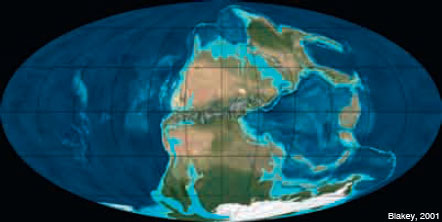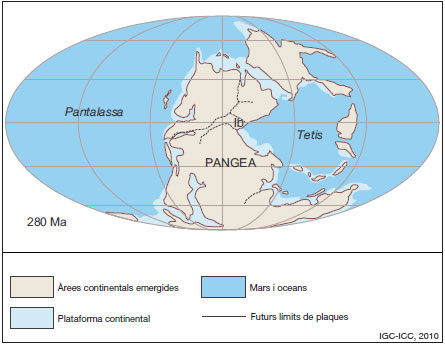In that which will be the future Iberian Plate, the sedimentary record of the Cambrian and the Ordovician is mainly formed of siliciclastic and carbonate deposits from the marine platform or deeper, in which the first trilobites lived and where archeocyatids colonies are formed. One of the characteristics of the Cambrian is the appearance of numerous forms of life; many of them with skeletal components, and which is called the great life explosion of the Cambrian. At the end of the Ordovician an emersion period took place, during which the detrital deposits settled and an intensive volcanic activity was registered. At the end of this period the first great extinction took place, in which 85% of the species disappeared.
The Gondwana supercontinent started its fragmentation some 480 Ma ago, during the Paleozoic, marking the beginning of the Hercynian cycle. With time, three large continental plates called Siberia, Laurentia and Baltica, were separated (figure 3) and other smaller continental fragments, such as Avalonia, separated from the rest of the supercontinent by the Reic Ocean.
With this fragmentation the marine conditions returned, mainly in platform environments. During the Silurian (figure 3) the environmental conditions were very peculiar with deposits of black clays, very rich in organic matter, an indication of euxinic (anaerobic and reducing) conditions. Graptolites and some cephalopods are the typical organisms of this period. During the Devonian and part of the Carboniferous shallow marine platform carbonates were deposited. These deposits were very rich in fauna (cephalopods, trilobites, corals, fish and other organisms). Some deep marine sediments were also deposited, such as the red limestone with goniatites (griotte limestone) and cumulative levels of radiolarians. At the same time, the first plants and amphibians started to colonize the emerged land. Towards the end of the Devonian, the second great extinction took place.
During the Carboniferous period, the fragmented plates at the beginning of the Hercynian cycle re-converged and collided with the remains of Gondwana, giving place to an important deformation event, the Hercynian orogeny. This belt is characterized by fold structures accompanied by metamorphic processes of great importance and by an intense intrusive magmatic activity. The sediments of this stage are marine detritals (those denominated Culm facies), indicative of the tectonic activity and of the erosion of the large mountain ranges which were being formed. The remains of the Hercynian mountain range are, even today, well visible throughout the west of Europe, especially to the west of the Iberian Peninsula. In Catalonia, smaller fragments crop out in the Pyrenees, in the Coastal Mountain Ranges and in the basement of the Ebro Basin.
At the end of the Hercynian orogeny, some 305 Ma ago, the continental masses of the planet were joined together (figures 4 and 5), forming one supercontinent called Pangea, which in Greek means “all the Earth”. Pangea was surrounded by a global ocean, known as Panthalassa, which means “all the seas”. A large gulf extended on the eastern side of Pangea which received the name of Tethys.
Broadly speaking the future Iberian Plate was, at that moment, situated at the extreme west of Tethys and limited to the north with the future European Plate, to the west with the future North American Plate and to the south with the future African Plate (figure 5).
At the end of the Carboniferous and the beginning of the Permian, some 300 Ma ago, the reliefs created during the Hercynian orogeny were subjected to intense erosion. The fault systems generated in an extensive tectonic context individualized structural summits and intra-mountain basins, which received alluvial sediments and were occupied, to a great extent, by marshy and lacustrine areas. In the area that at the present time corresponds to the Pyrenees, the volcanic activity was outstanding. The vegetation, which from the Devonian had started to colonize the continents, was luxuriant. In some of these marshy areas important quantities of plant remains were accumulated which, on maturing, were converted to coal: hence, the name of this period. Towards the end of the Permian, some 250 Ma ago, vast areas of the continent had been reduced by the erosion to extensive plains, those called peneplains. Also, at this moment the third great extinction took place. All these circumstances determine the boundary between the Paleozoic and the Mesozoic, some 250 Ma ago.

 Contact
Contact









